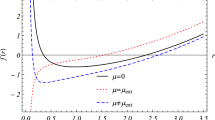Abstract
We extend the Induced Matter Theory of gravity (IMT) to 5D curved spacetimes by using the Weitzenböck representation of connections on a 5D curved spacetime. In this representation the 5D curvature tensor becomes null, so that we can make a static foliation on the extra non-compact coordinate to induce in the Weitzenböck representation the Einstein equations. Once we have done it, we can rewrite the effective 4D Einstein equations in the Levi-Civita representation. This generalization of IMT opens a huge window of possible applications for this theory. A pre-big bang collapsing scenario is explored as an example.
Similar content being viewed by others
Notes
In our conventions indices “a,b,c,…,h” run from 1 to 5, “A,B,C,…,H” run from 1 to 5, Greek indices α,β,γ run from 1 to 4 and indices “i,j,k,…” run from 2 to 4.
Notice that for fermionic fields (for instance with spin 1/2), the Cartan equation (22) should be
$$ \overbrace{{S}_{\beta\gamma}}^{\mathrm{4D}} - \frac{1}{2} \sigma_{\beta\gamma} S =-8 \pi G \,\underbrace{\overbrace {{T}_{\beta\gamma}}^{\mathrm{4D}}}_{(\mathrm{ant})}, $$where S=σ μν S μν , \(\sigma^{\mu\nu}={1\over2} [\gamma^{\mu}, \gamma^{\nu} ]\) and γ μ are the Dirac matrices. However, this issue is beyond the scope of this work.
In the cases where \(M_{\mathrm{eff}}^{2} >0\) and the universe expands with a nearly constant energy density given by ρ≃〈V(φ)〉 and a pressure P≃−〈V(φ)〉, the potential (55) is a good candidate to describe inflation.
References
G. Veneziano, Phys. Lett. B 265, 287 (1991)
M. Gasperini, G. Veneziano, Astropart. Phys. 1, 317 (1993)
M. Gasperini, G. Veneziano, Mod. Phys. Lett. A 8, 3701 (1993)
M. Gasperini, G. Veneziano, Phys. Rev. D 50, 2519 (1994)
J.E. Campbell, A Course of Differential Geometry (Clarendon, Oxford, 1926)
E. Anderson, F. Dahia, J. Lidsey, C. Romero, J. Math. Phys. 44, 5108 (2002)
H. Liu, P.S. Wesson, Astrophys. J. 562, 1 (2001)
P.S. Wesson, Phys. Lett. B 276, 299 (1992)
J.M. Overduin, P.S. Wesson, Phys. Rep. 283, 303 (1997)
T. Liko, Space Sci. Rev. 110, 337 (2004)
P.S. Wesson, Space Sci. Rev. 59, 365 (1992)
J. Ponce de Leon, Mod. Phys. Lett. A 16, 1405 (2001)
S.S. Seahra, P.S. Wesson, Class. Quantum Gravity 19, 1139 (2002)
R. Weitzenböck, Invarianten Theorie (Noordhoff, Groningen, 1923)
M. Gasperini, G. Veneziano, Phys. Rep. 373, 1 (2003)
N.J. Poplawski, Phys. Lett. B 694, 181 (2010)
E. Cartan, C. R. Math. Acad. Sci. Paris 174, 593 (1922)
N.J. Poplawski, Phys. Rev. D 85, 107502 (2012)
K. Hayashi, T. Shirafuji, Phys. Rev. D 19, 3524 (1979). Addendum-ibid. Phys. Rev. D 24, 3312 (1982)
R. Ferraro, F. Fiorini, Phys. Rev. D 75, 084031 (2007)
M. Bellini, Phys. Lett. B 705, 283 (2011)
M. Bellini, Phys. Lett. B 709, 309 (2012)
Acknowledgements
The authors acknowledge P.S. Wesson for his interesting comments. Furthermore, we acknowledge UNMdP and CONICET Argentina for financial support.
Author information
Authors and Affiliations
Corresponding author
Rights and permissions
About this article
Cite this article
Romero, J.M., Bellini, M. Induced Matter Theory of gravity from a Weitzenböck 5D vacuum and pre-big bang collapse of the universe. Eur. Phys. J. C 73, 2317 (2013). https://doi.org/10.1140/epjc/s10052-013-2317-x
Received:
Revised:
Published:
DOI: https://doi.org/10.1140/epjc/s10052-013-2317-x




